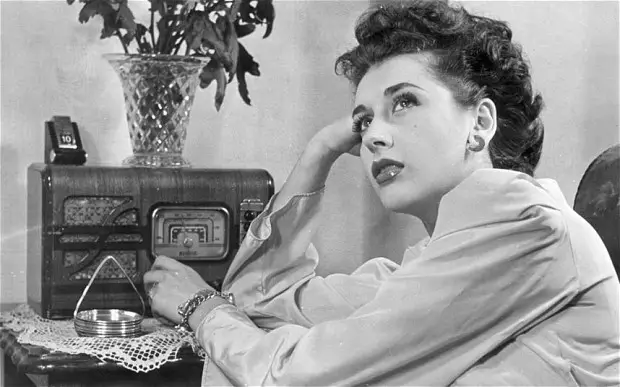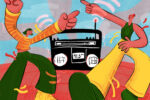Radio Lives
Despite a shifting technological landscape, radio is thriving, hosting more weekly users than Facebook.
By Ben Zhang, Duke University
In 1979, the Buggles declared that “Video Killed the Radio Star.”
Nearly forty years later, radio may seem like an anachronism, a relic of times long gone by. Perhaps you’ve heard people say that the medium is almost certainly on its way out, doomed to fall victim to the rapid technological changes of the 21st century. But are these statements grounded in reality?
A closer look reveals that the reports of radio’s death appear to be greatly exaggerated. A recent Nielsen report revealed that 243 million people in the United States listen to radio at least once a week. That figure comes out to a whopping 91 percent of Americans aged 12 or above. In fact, more Americans listen to the radio per week than use Facebook, as surprising as it may seem. So, at least in terms of sheer numbers, radio is thriving, not dying.
Of course, the power of the almighty dollar cannot be ignored. Radio’s audience is important, but so is its ability to make enough money to support itself. Happily for the owners of stations around the country, radio appears to be doing just fine when it comes to financials. A study by Nielsen Audio and Nielsen Catalina Solutions indicated that every $1 spent toward radio advertising generated an $6 increase in sales.

Research has consistently confirmed the effectiveness of radio ads. Another study by Nielsen and the Katz Radio Group, for example, followed a campaign by American Family Insurance (AFI) to promote its slogan (“Your dream is out there. Go get it. We’ll protect it”). Those who heard AFI’s radio ad were 43 percent more likely to associate the slogan with the company than those who did not.
Naturally, numbers can only tell one side of the story. Part of radio’s appeal lies in the nature of the medium itself. For starters, surveys have indicated that the medium has a distinct “local feel,” which perhaps lends it some additional authenticity. In addition, unlike television or film, radio contains no pictures or images you can latch onto. To some, the lack of visual cues may be an immediate turn-off, which is understandable. After all, 77 percent of Americans now own a smartphone, and over half of the public is now in possession of a tablet.
From an early age, children grow up staring at screens and making associations between images and ideas. So, some may find the idea of listening to a ten-minute story with only audio present unbearable. The lack of visuals, however, forces you to concentrate on the words being spoken. When you hear someone being interviewed, you must try to imagine what they look like based solely on their voice, and when a scene is being described, you must again rely on mental pictures alone.
As a result of all the aforementioned efforts, you are likely to be more engaged with a piece if it is heard on the radio instead of being seen on television or some other form of visual media. In a world where it is harder than ever to focus on anything for more than a few seconds, longer attention spans are definitely welcome.
Perhaps it is a good thing, then, that commutes in the United States are getting longer and more sedentary. More time spent sitting in cars means a greater chance that people will turn on the radio. For instance, the medium still remains the most popular method of listening to music while driving. Turning on the radio can be a great way to relax after a long day at the office, or a momentary reprieve from the frustrations of navigating a car through heavy traffic.
Not all the news regarding radio is positive, however. There are indicators that the people predicting the medium’s demise may finally be right—in a sense. For starters, today’s younger millennials (defined as those between the ages of 15 and 19) are turning away from what is traditionally thought of as “radio.” In related news, the audience for National Public Radio (NPR) programs has gotten noticeably older in recent years. Such changes in demographics have led to some pretty dire predictions. For example, media industry analyst Gordon Borrell recently declared that half of the AM/FM radio stations in the United States will be out of business within a decade.
However, the jury is still out on whether people like Borrell should be taken seriously. After all, while it is possible that traditional radio may falter in the near future, other forms of the medium are starting to sprout wings. The number of people listening to radio online, for example, has increased steadily in recent years. Those who venture to the interwebs are looking for podcasts in addition to music.
Yes, podcasts—those online audio series that you can download and listen to on your own time. Podcasts have exploded in popularity since the term was coined by Ben Hammersley about a decade ago.
Even if the radio doomsdayers’ predictions turn out to be true, podcasts will likely be here to stay.
The form is an excellent introduction to the changing world of radio programs, especially for those who don’t actually own a radio or may be squeamish about getting one.
If you are looking for a good podcast to listen to, I would recommend checking out “Radiolab,” a self-described “show about curiosity” where “sound illuminates ideas, and the boundaries blur between science, philosophy, and human experience.” Hosted by the talented pairing of Jad Abumrad and Robert Krulwich, “Radiolab” dives deep into a wide variety of topics, often those of a scientific or philosophical nature, and always finds ways to make the ensuing discussions both interesting and accessible. To give you an idea of “Radiolab”’s breadth, some of its recent episodes have focused on Alzheimer’s disease, meat allergies, triage and the Guadeloupe raccoon. In the “Radiolab” universe, there is sure to be something you will find interesting.
To keep up with the demands of a changing audience, producers of podcasts have begun to curate stories that will appeal to younger demographics. “Snap Judgment” is a good example. Hosted by Glynn Washington, the show features episodes centered around themes such as “Born Identity” and “Personal Jesus.” The segments aim to tackle issues that millennials care about, a concept that is spreading like wildfire.
“Radiolab” spin-off “More Perfect,” which discusses cases from the Supreme Court, and WYNC’s “Nancy,” an LGBTQ-themed show that made its debut just this past week, are good examples. Such podcasts illustrate radio’s influence nicely. Though the medium may change, it will likely still be as relevant as ever for many decades to come. Audiophiles everywhere, rejoice.


















[…] https://studybreaks.com/2017/04/20/radio-2/ […]
[…] great thing about radio is how effective it is compared to how expensive it is. According to Nielsen, radio has an average return on investment of $6 for every $1 invested. This figure has been shown […]
[…] great thing about radio is how effective it is compared to how expensive it is. According to Nielsen, radio has an average return on investment of $6 for every $1 invested. This figure has been shown […]
[…] great thing about radio is how effective it is compared to how expensive it is. According to Nielsen, radio has an average return on investment of $6 for every $1 invested. This figure has been shown […]
[…] Radio is substantially cheaper than TV ads, and even most press ads. In fact, according to Nielson, radio ads have an average ROI of $6 for every $1 invested. And this figure is just based on […]
[…] great thing about radio is how effective it is compared to how expensive it is. According to Nielsen, radio has an average return on investment of $6 for every $1 invested. This figure has been shown […]